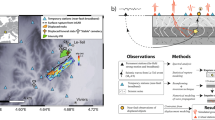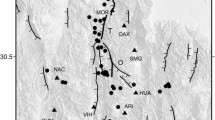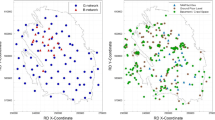Abstract
The purpose of this paper is to summarize the strong motion data from thenearest stations to the fault ruptures of the August 17, 1999 Kocaeli andNovember 12, 1999 Düzce earthquakes and to document informationthat will be significant for its interpretation. Significant engineeringcharacteristics of the near-field strong motions are discussed, with particularemphasis on the site conditions, rupture directivity effects and transversecomponent orientations relative to the fault. In the course of this study,the most significant strong motion stations and adjacent parts of the faultare visited. All locations are verified using a hand-held GPS receiver. Thusinstrument housing characteristics, preliminary impression on siteconditions, and relatively precise relationship of the stations to the nearestfaulting can be reported.
Similar content being viewed by others
References
Anderson, J.G., Sucuoğlu, H., Erberik, A., Yılmaz, T., İnan, E., Durukal, E., Erdik, M., Anooshehpoor, R., Brune, J.N. and Der Ni, S., 2000, Ground motions: Implications for seismic hazard analysis, Earthquake Spectra 16 (Suppl. A), 113-137.
Arias, A., 1970, A measure of earthquake intensity, in Seismic Design for Nuclear Power Plants, MIT Press, Cambridge, MA, pp. 483-469.
Bakır, S.B., Sucuoğlu, H., and Yılmaz, T., 2002, An overview of local site effects and the associated building damage in Adapazarı during the 17 August 1999 Kocaeli earthquake, Bulletin of the Seismological Society of America, in press.
Housner, G.W., 1952, Spectrum intensities of strong motion earthquakes, Proc. Symp. Earthquake and Blast Effects in Structures, EERI, LA, CA, pp. 21-36.
Lettis, W., Bachhuberr, J., Witter, R., Barka, A., Bray, J., Page, W. and Swan, F., 2000, Surface fault rupture, Earthquake Spectra 16 (Suppl. A), 11-53.
Somerwille, P.G., Smith, N.F., Graves, R.W. and Abrahamson, N.A., 1997, Modification of empirical strong ground motion attenuation relations to include the amplitude and duration effects of rupture directivity, Seism. Res. Lett. 68, 199-222.
Sucuoğlu, H. and Nurtuğ, A., 1995, Earthquake ground motion characteristics and seismic energy dissipation, Earthquake Eng. Str. Dynamics 24, 1195-1213.
Sucuoğlu, H., 2000, The 1999 Kocaeli and Düzce-Turkey Earthquakes, Proceedings, Mitigation of Seismic Risk, Support to Recently Affected European Countries, Workshop organised by European Commission Belgirate, Italy.
Trifunac, M.D. and Brady, A.G., 1975, A study on the duration of strong earthquake ground motion, Bull. Seism. Soc. Am. 65, 581-626.
Author information
Authors and Affiliations
Rights and permissions
About this article
Cite this article
Sucuoğlu, H. Engineering characteristics of the near-field strong motions from the 1999 Kocaeli and Düzce Earthquakes in Turkey. Journal of Seismology 6, 347–355 (2002). https://doi.org/10.1023/A:1020083308693
Issue Date:
DOI: https://doi.org/10.1023/A:1020083308693




